Window seats are a great way to give yourself a cozy nook for reading, relaxing, or enjoying the view. These built-in features add character to a room and often come with the bonus of extra storage space. Upgrading a window seat can be a great way to take an awkward space in your home and turn it into something functional and comfortable.
1. Bay-Window Daybed
Bay windows are perfect for a window seat. A well-designed bay window daybed can serve as a focal point, offer a comfortable spot to relax, and allow you to take advantage of natural light and outdoor views. Look for opportunities for a bay-window daybed in living rooms, bedrooms, and even spacious kitchens, where a cozy corner can be a great addition.
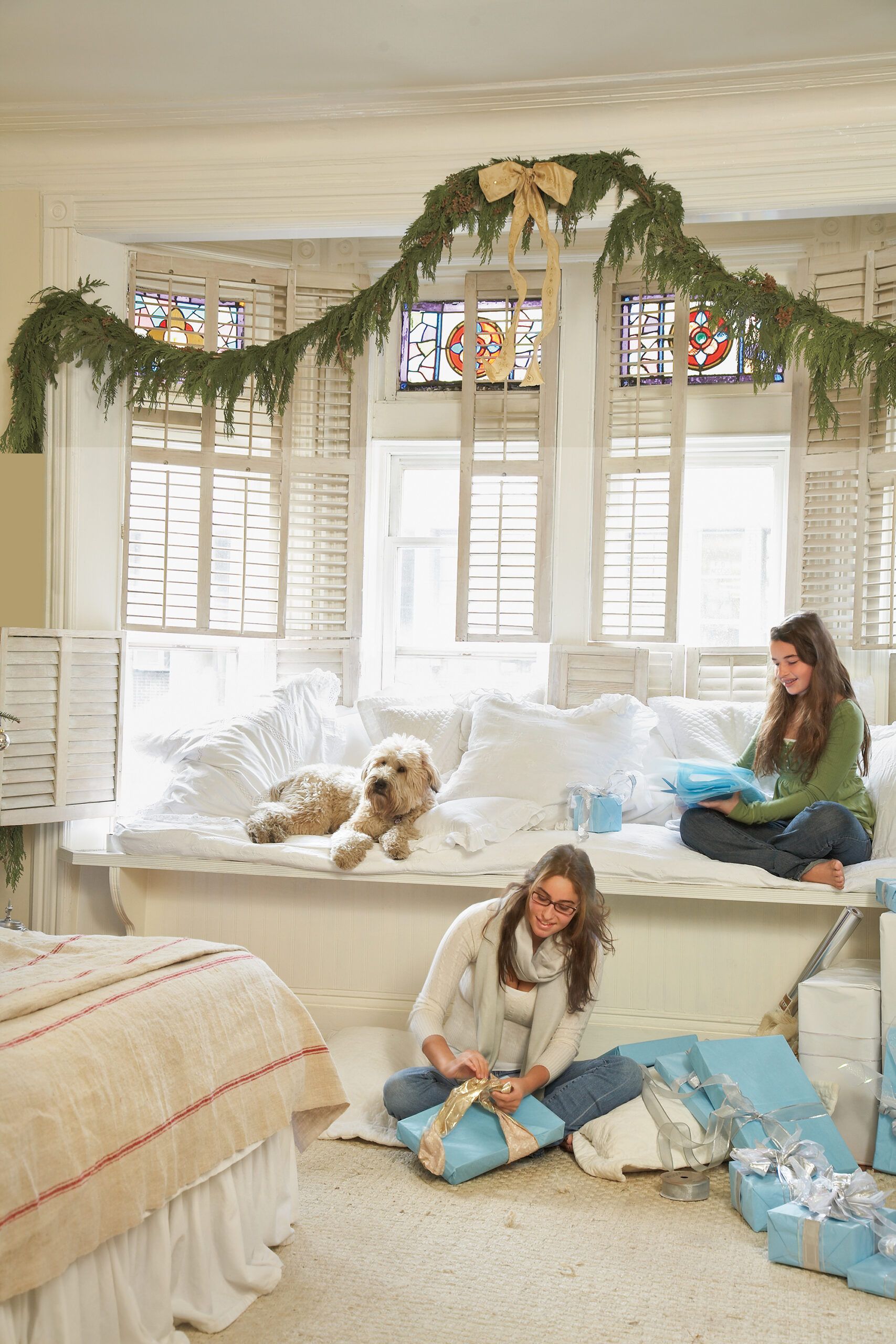
A long, deep bench lined with plush oversized cushions forms an ideal lounge area. The all-white color scheme shown above keeps the space feeling light and airy, while decorative brackets support the seat’s overhang and add a touch of elegance. Tall base molding ties the window seat seamlessly into the room’s existing architecture. Consider this approach for spaces with large bay windows, as it integrates naturally with the room’s existing design elements.
Tip: To control light in rooms with large windows, add adjustable window coverings like interior shutters or blinds. These allow you to manage brightness levels and provide privacy when needed, especially in bedrooms where you may want to block out early morning sunlight. Layering the shutters with sheer drapes is another way to add style and give you adjustable light filtering options.
2. Two-Tier Built-In
A two-tier built-in window seat is an excellent solution for rooms with awkwardly placed windows at different heights. This clever design makes the most of the available space with a cohesive look that ties the room together. The upper tier can serve as a display shelf or bookcase, while the lower tier provides comfortable seating and additional storage. This setup is great for dens, home offices, and living rooms where the window seat can help integrate different functional zones.
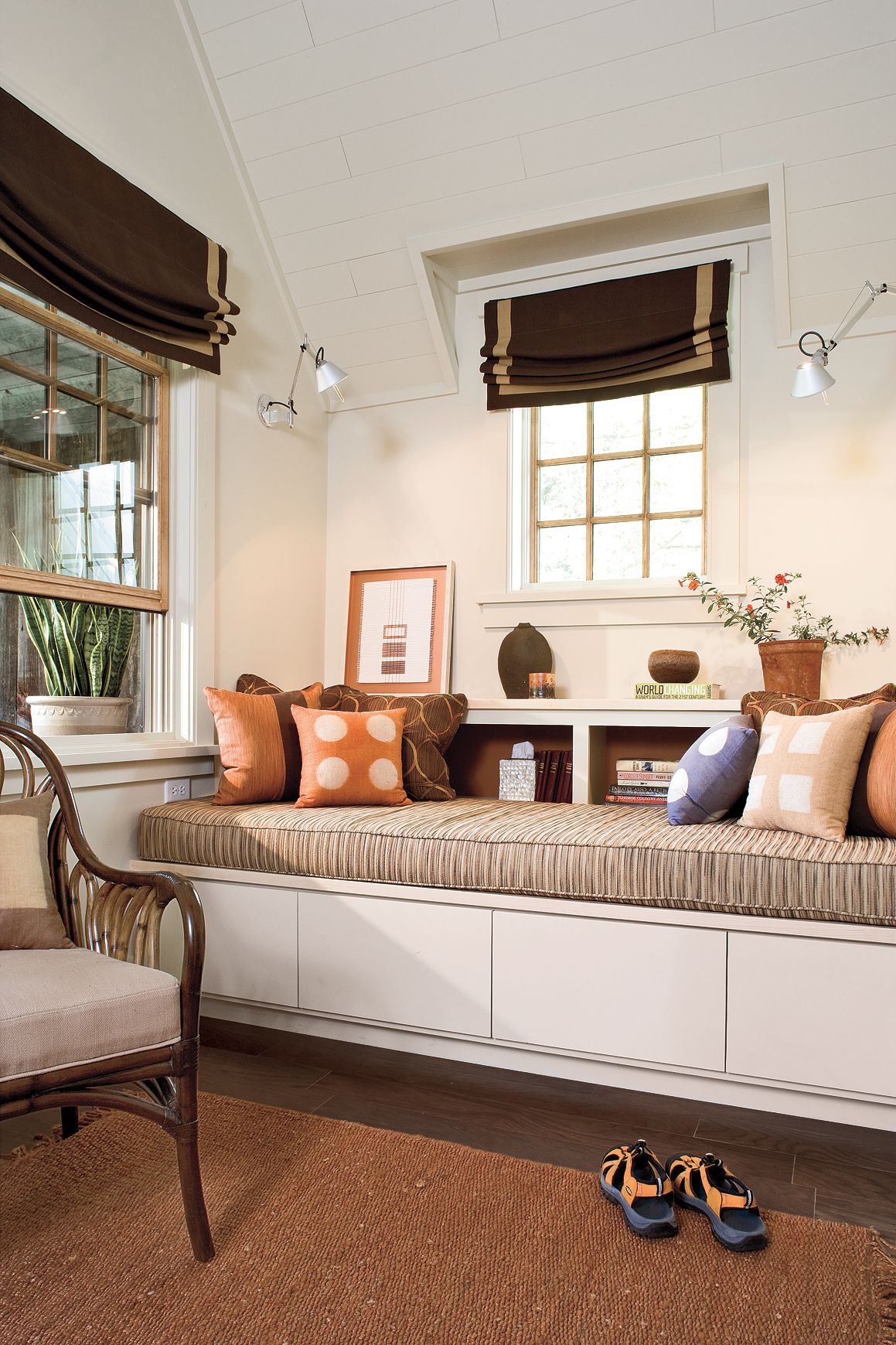
In this home office example, the bookshelf back has keepsakes and reading material beneath the high window, while the cushioned base fits snugly under the sill of the lower window. The bottom section doubles as a practical storage solution with flush-front drawers big enough to hold legal-size file folders.
Tip: To create a more intimate feel for your window seat, lower the ceiling above it by a few inches with a soffit that slopes gently toward the window. This architectural detail can make the seating area feel cozier and more defined within the larger room. This technique can also help create a sense of separation between the window seat and the rest of the room, making the window seat feel like the perfect retreat.
3. Sofa Bed
An extra-deep window seat can serve multiple purposes, functioning as a comfortable couch for daytime use and a convenient sleeping space for overnight guests. This versatile design is great for homes where space is at a premium or in rooms that need to serve multiple functions. It can transform a regular living area into a multifunctional space without compromising on style or comfort.
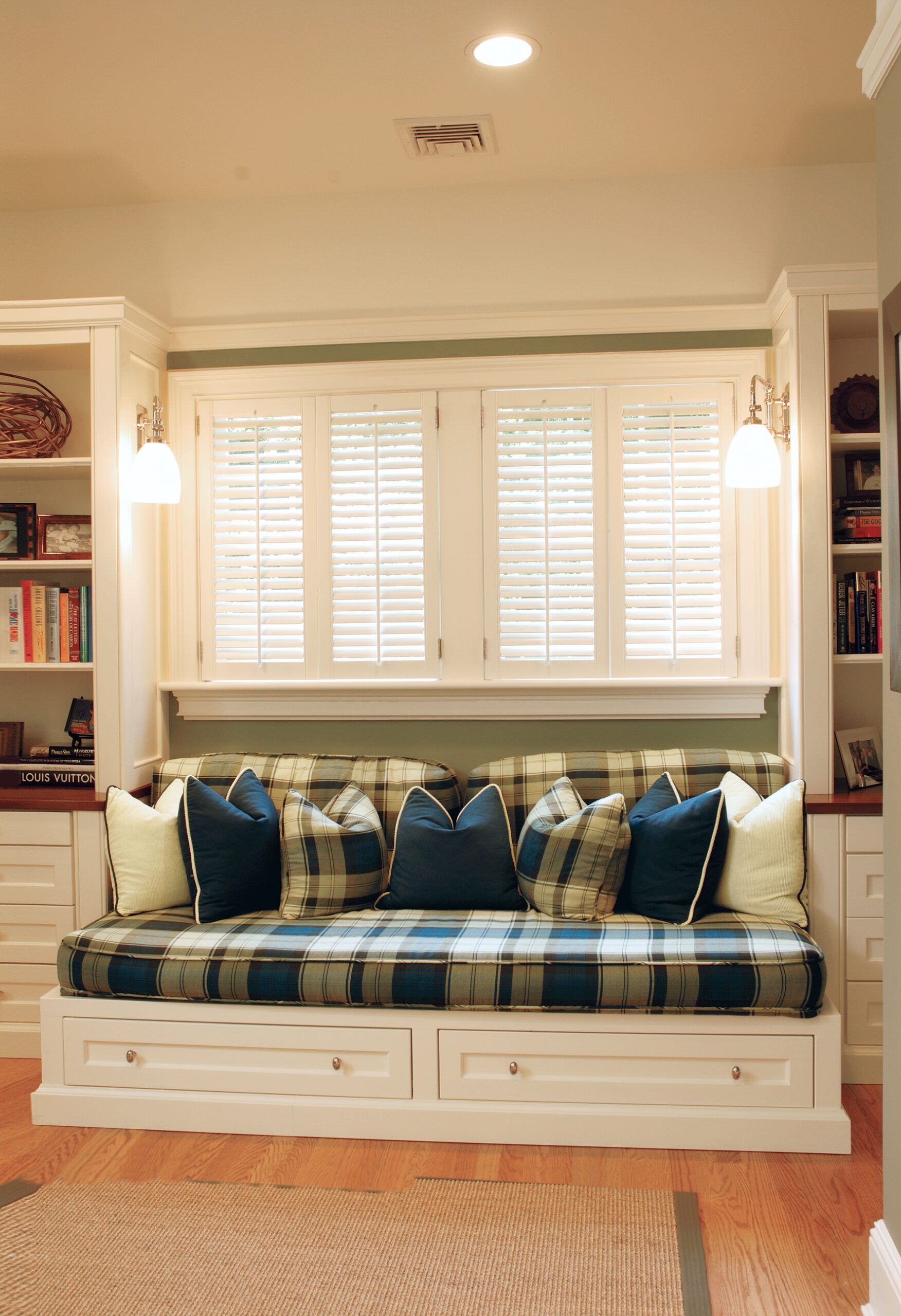
To create a sofa bed window seat, build the frame to accommodate a standard twin or full-size mattress—typically about 39 by 75 inches or 54 by 75 inches, respectively. You can use a ready-made mattress as a cushion instead of having to get a custom size. For everyday use, a dark-colored or patterned fitted sheet works as a practical cover. Add plenty of back pillows to create a cozy seating area. Incorporate built-in drawers under the seat for storage. This practical design keeps the space functional and clutter-free.
Tip: For the perfect reading light, install a pair of sconces directly above a sofa-style window seat. Position them about 6 feet from the floor to provide enough clearance. This will give you comfortable reading light after sunset while adding a touch of elegance to the room.
4. Pair of Perches
Creating a pair of window seats on either side of a central feature, such as an entertainment center, can maximize both the style and function of a family room. This layout provides semi-private nooks for children or adults to retreat to while maintaining an open feel and preserving views from large windows. It also creates symmetry to make your room feel more balanced and harmonious.
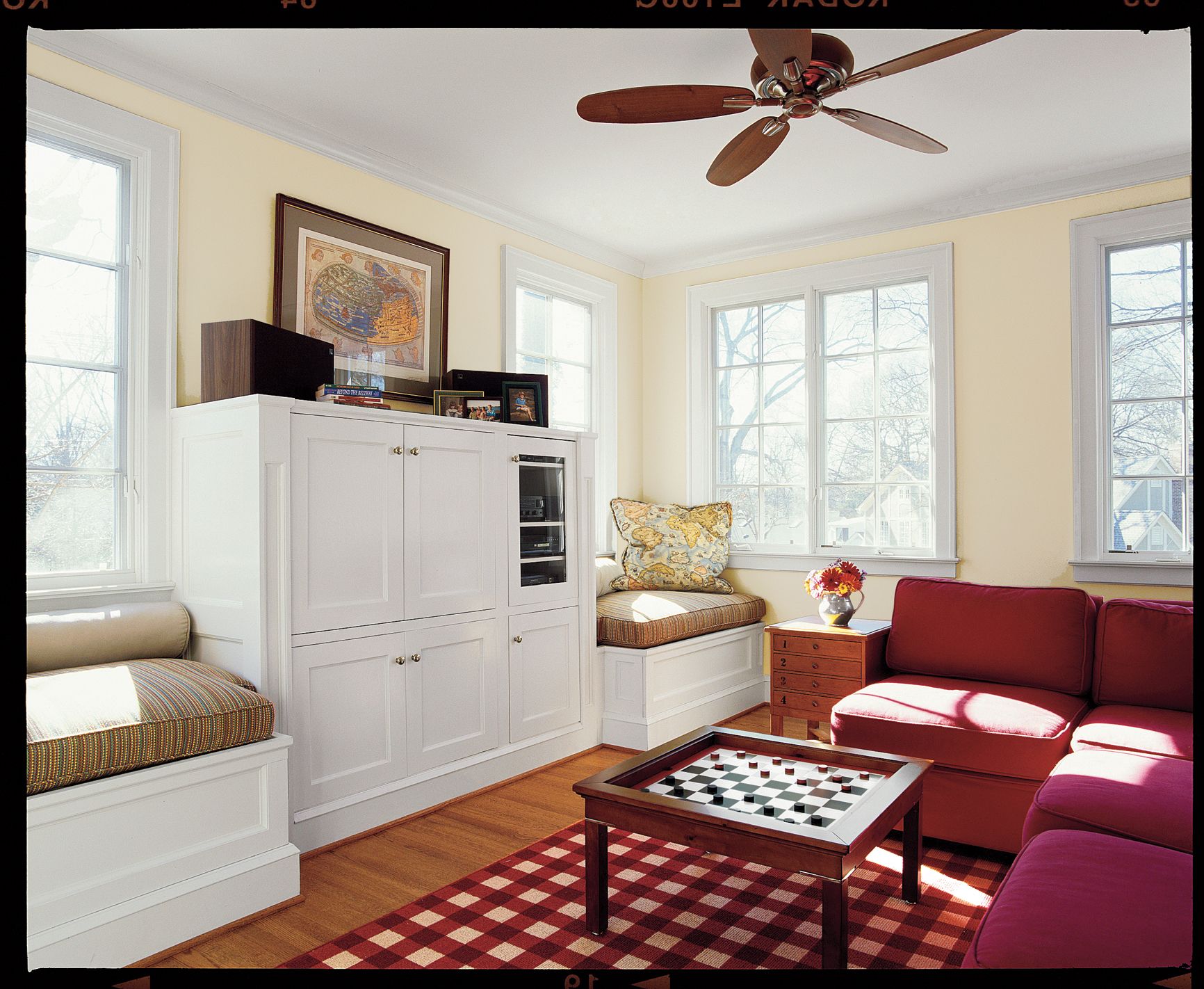
In this example, small benches flank the family room’s entertainment center, forming an attractive wall of built-ins. The paneled seat fronts echo the design of the media cabinet doors. These corner units take full advantage of wraparound views and even feature tops that lift to reveal hidden twin-size pull-out beds—perfect for sleepovers or accommodating extra guests. This dual functionality makes the family room both practical and welcoming.
Tip: When designing a window seat for one person, aim for a minimum depth of 22 inches. However, if space allows, a depth of 30 to 36 inches is more comfortable. For length, a minimum of 36 inches end to end is recommended for adequate seating space.
5. Space Saver
In areas where space is limited or where traffic flow is a concern, a compact window seat is a great alternative to a traditional couch. This solution is great in sunrooms or areas where bulky furniture might block movement. A window seat like this can help create a welcoming environment without overcrowding the space.
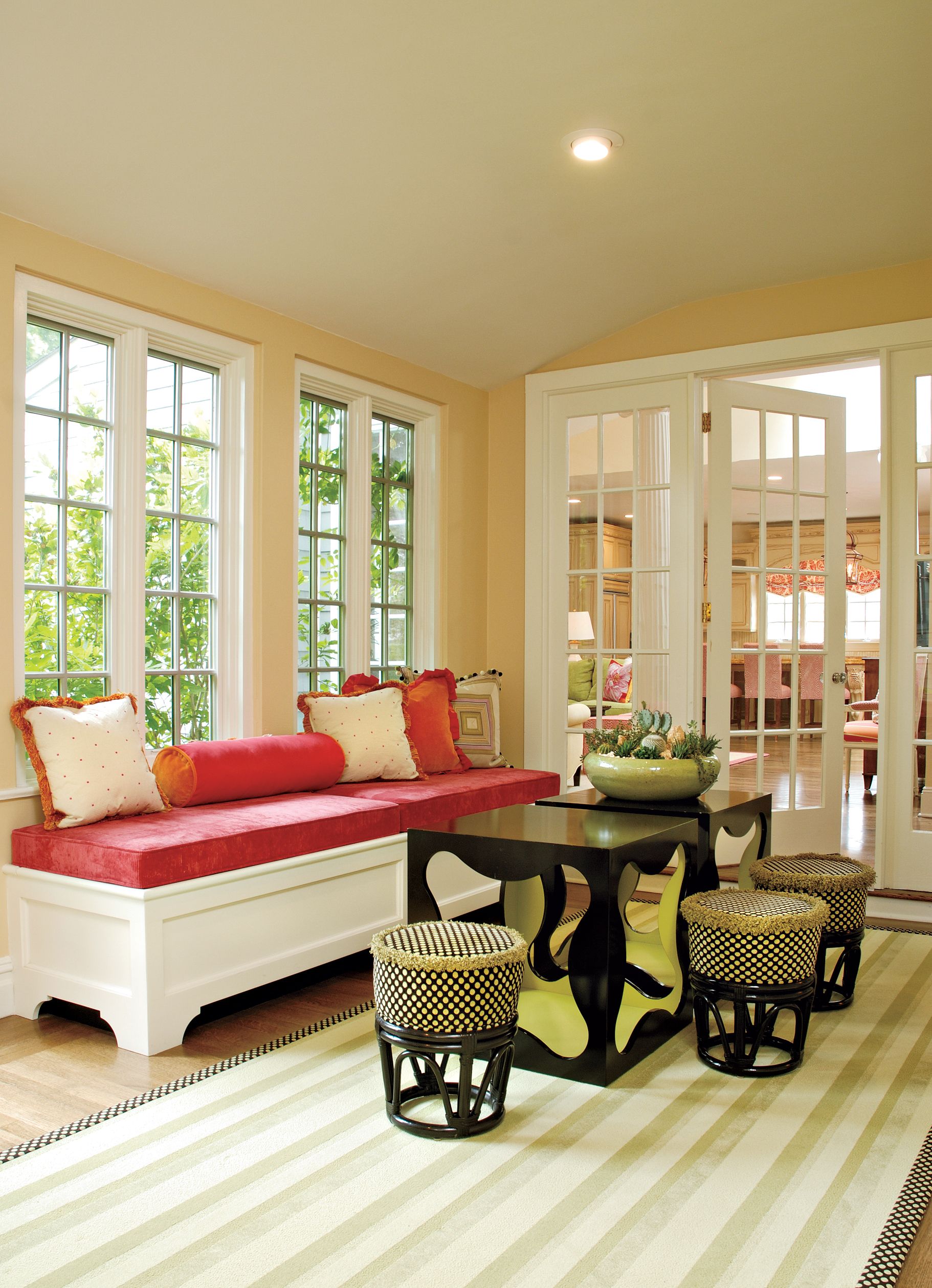
The window seat shown here is an example of how to create the feeling of a living room in a tight space. Colorful, upscale fabrics and curved feet give the bench a furniture-like appearance. A mix of plush throw pillows increases comfort without obstructing the tall windows behind them. Small, movable furniture pieces like cube-style coffee tables and stools can be rearranged to accommodate guests as needed.
Tip: For maximum comfort, build your window seat bench to a height of about 15 inches. Adding a 3-inch cushion will bring the total seat height in line with most standard chairs. This alignment keeps the seating comfortable and visually consistent with other pieces of furniture in the room.
6. Storage Center
A window seat can significantly enhance storage capacity in small bedrooms while providing a cozy nook for reading or relaxation. By incorporating cabinetry around and beneath the seat, you can create a multifunctional space that addresses storage and seating needs. This design is useful in children’s rooms, guest rooms, and small apartments where space is at a premium.
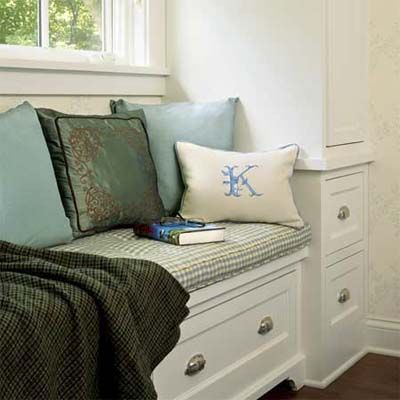
In this bedroom example, a windowed wall of cabinetry combines convenient clothing storage with a cozy reading nook. While more expensive than a simple flip-top compartment, installing drawers beneath the seat provides easier access to stored items without needing to remove the cushions. This type of storage solution can be particularly useful in mudrooms for organizing sports gear or in breakfast nooks for storing place settings and linens.
Tip: To create a comfortable and durable cushion for your window seat, use medium-density or firm foam for the core and wrap it with cotton batting. Cover the cushion with upholstery-grade laminated fabric for maximum durability, or apply a stain-resistant treatment to lighter-weight materials to protect against wear and tear. This combination is durable and easy to maintain.
7. Bathroom Organizer
Incorporating a window seat in a bathroom might seem like an extravagant use of space, but it can actually maximize storage while creating a convenient spot to sit or place towels as you get in or out of the bath or shower. This works well in smaller bathrooms where every inch of space counts. It can elevate the bathroom’s design and provide practical benefits that enhance daily routines.
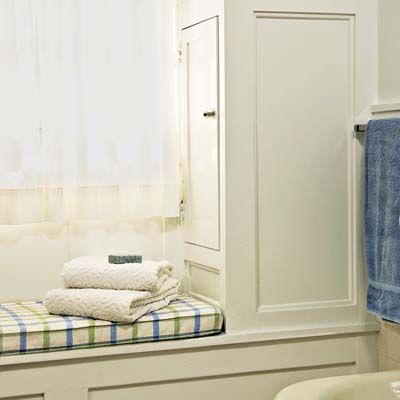
In this example, a deep cabinet accessed from the side is the perfect seat and storage container. It provides ample storage for bulk-purchased paper products and other bathroom essentials, while the flip-top bench offers space for extra towels and hygiene products. By combining storage and seating, this window seat design makes efficient use of the space.
Tip: When designing a storage unit with doors that open over the seat, consider the space constraints of the room. In tight spaces, it’s often better to have doors that open over the seat rather than into the room, preventing obstruction of walkways or other fixtures.
8. Inglenook Style
An inglenook-style window seat takes advantage of corner configurations to create a charming seating area that combines occasional seating with open storage. This design works well near fireplaces, creating a cozy gathering spot for small groups. It can also serve as a focal point that enhances a room’s architectural features and ambiance.
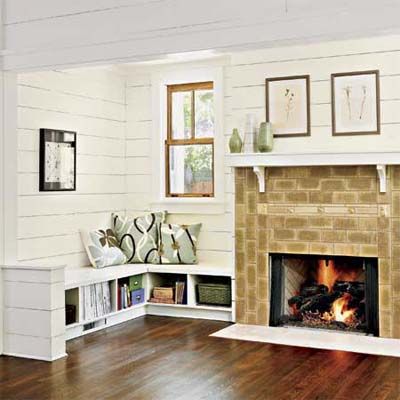
The L-shaped bench shown here offers convenient storage for items like photo albums and magazines while inviting people to gather around the fireplace. A low half-wall at the end of the seat serves as an armrest and provides a handy surface for setting down drinks. This design makes use of corner space that might otherwise feel awkward and empty. It encourages relaxation and social interaction in a comfortable setting.
Tip: Don’t let existing heat registers or baseboard units stop you from installing a window seat. An HVAC professional can extend ductwork to relocate a register or install a toe-kick heater, allowing you to move forward with your window seat plans without compromising on heating efficiency.
9. Bookshelf Bench
Irregular wall shapes can make great niches for window seats. Combining a cozy seat with built-in bookshelves gives you the perfect reading oasis for bedrooms, studies, or living rooms. Having extra room for book storage is a plus for book lovers.
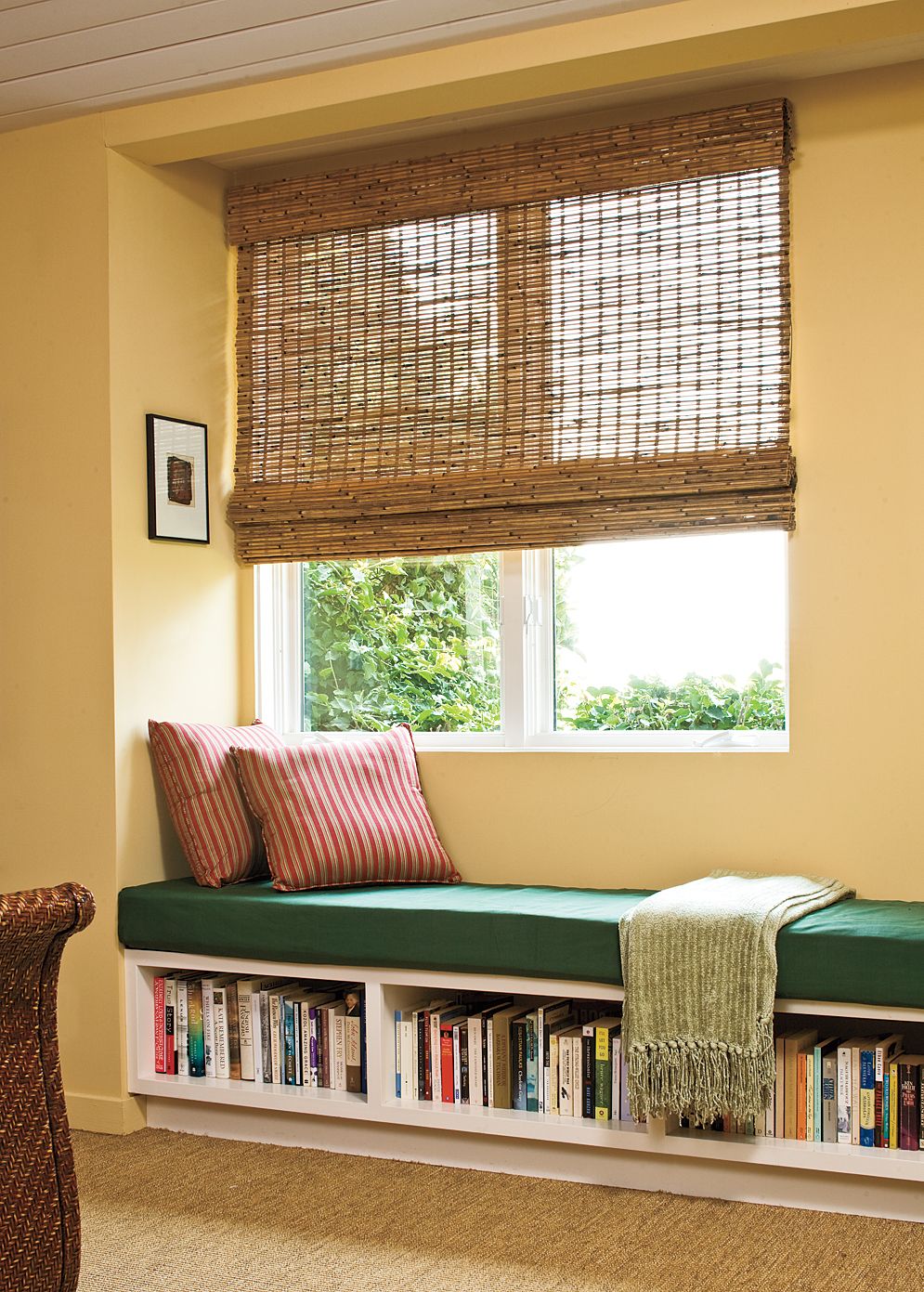
In this example, open shelves serve as the base for a bedroom window seat, creating a cozy reading corner. The seat extends 8 to 12 inches on either side of the window frame, while a length of about 5 feet invites people to stretch out comfortably with a good book. This setup contributes to a warm, inviting atmosphere while providing ample storage.
Tip: When incorporating open bookshelves into your window seat design, build dividers to support the seat and act as bookends. Adding toe-kick space elevates your mini-library off the floor, creating a more polished look and making cleaning easier. This arrangement helps your space remain clean and organized.
10. Vintage-Style Seat
For those looking to add a touch of period charm to their kitchen, a vintage-style window seat can be the perfect addition. This design adds character and functionality to the space. It seamlessly fits into both traditional and eclectic decor styles.
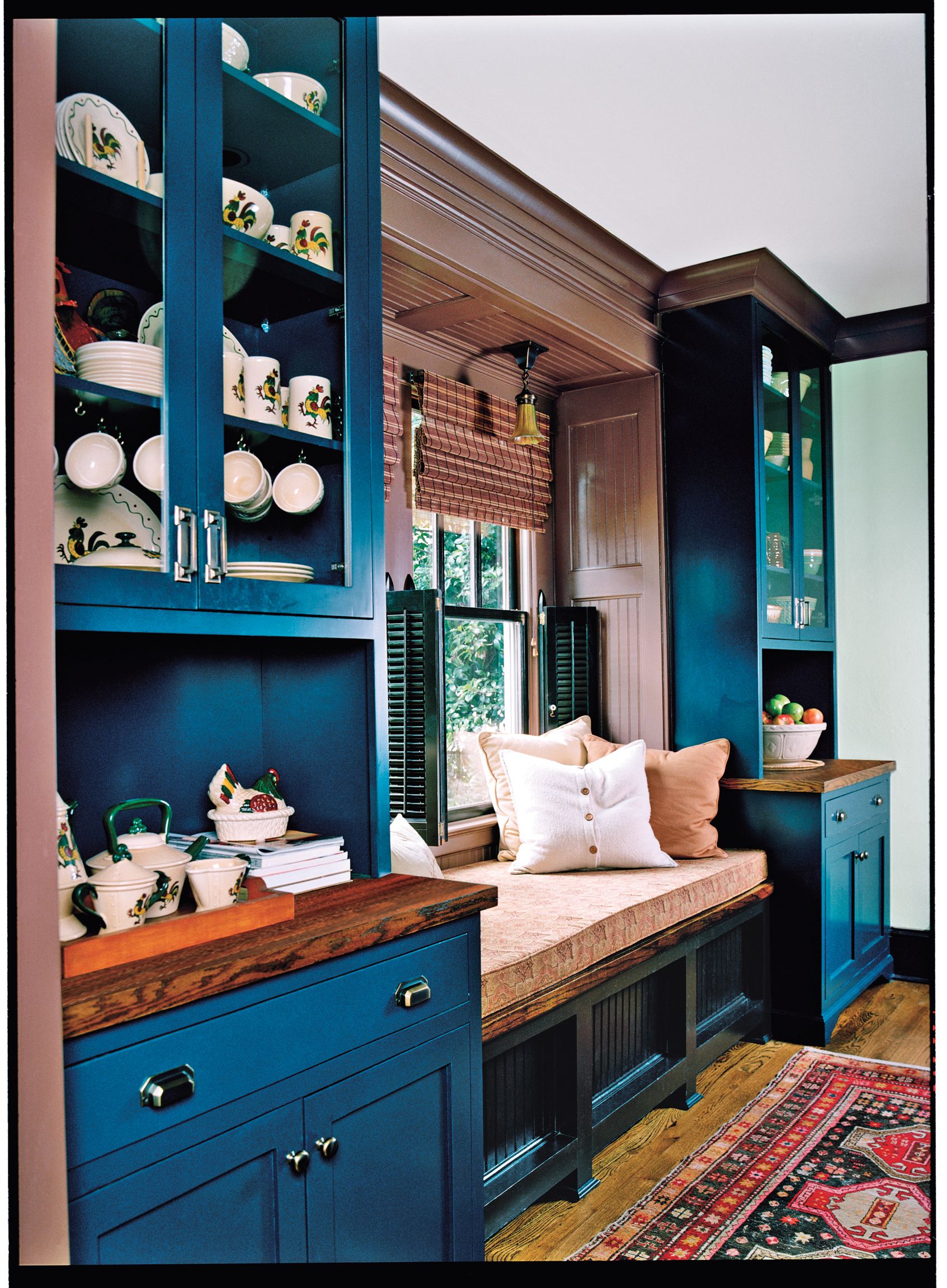
The window seat shown here is a great example of how to integrate a vintage-inspired piece into a modern kitchen. The stained oak top matches the counters on the flanking china cupboards to tie the design together, while the more elaborate millwork and high-gloss black paint make it feel like a separate, standalone piece. This versatile design can double as a banquette when paired with a small table, offering additional seating for casual meals or coffee breaks.
Tip: For window seats in high-traffic areas like kitchens, mudrooms, or dens where spills and stains are more likely, opt for patterned fabrics and removable, washable covers. That makes it easier to clean and maintain.
11. Stairway Getaway
Underneath the stairs is a hard area to make use of because of the awkward shape and size, but it’s perfect for a window seat. This design idea is a great choice in older homes where quirky architectural features can be turned into unique assets.
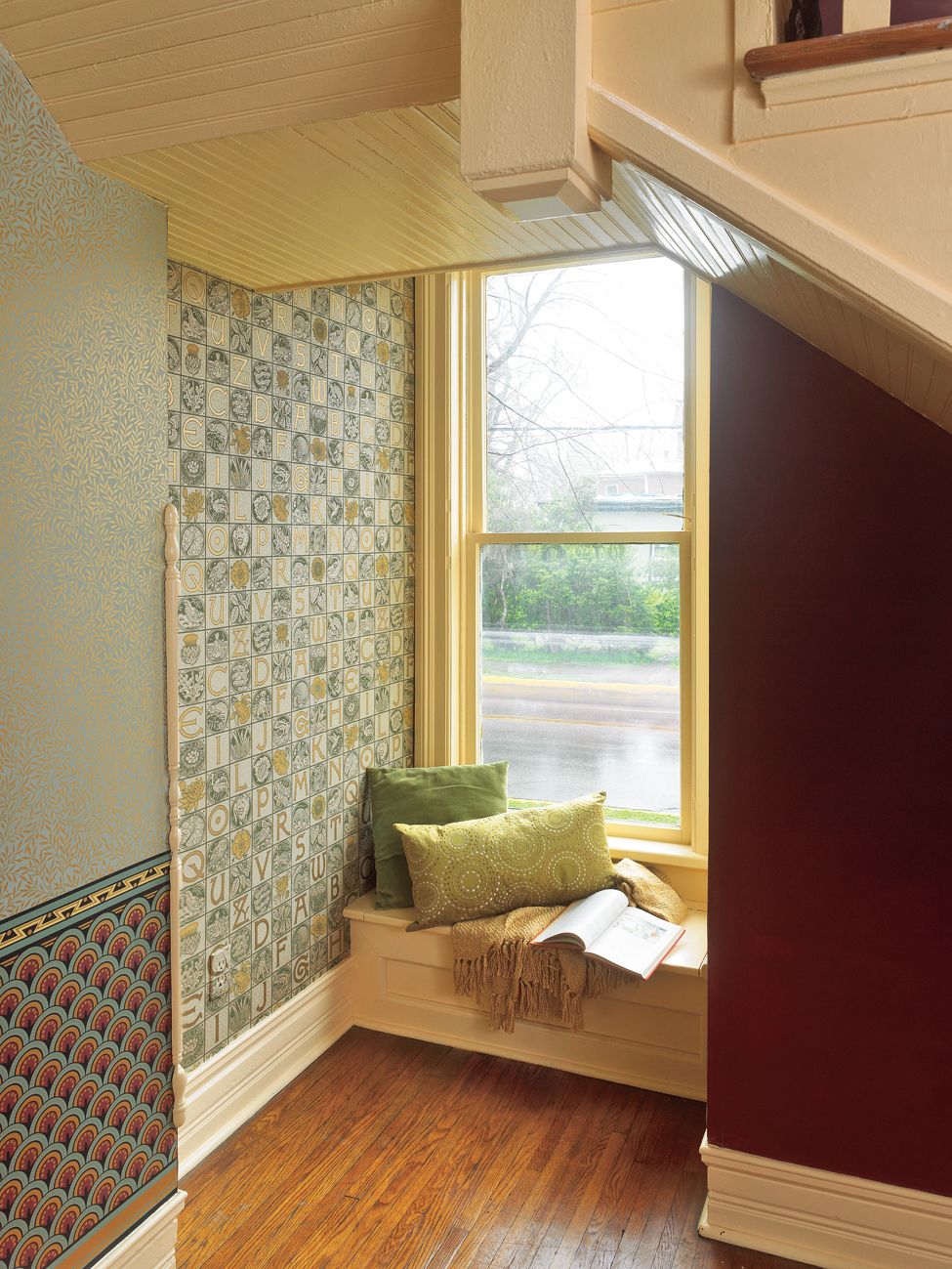
In this example, a small window seat tucked under the stairs off the foyer creates a secret nook that any child (or adult) would love. Similar opportunities can be found in attic spaces, where under-the-eaves areas can be converted into laid-back corners for reading or lounging. Wide stair landings or upstairs hallways with windows are prime locations for built-in window seats, adding both character and practicality to transitional spaces.
Tip: If you have space under a window near your front entry, build a flip-top bench. This creates a convenient spot to store extra scarves, gloves, and other coat-closet overflow items to keep your entryway organized. It’ll give you a well-organized and welcoming entrance to your home.
